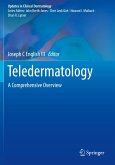This book offers a comprehensive and the foundational structure for all healthcare professionals developing, practicing, and performing research in teledermatology. The chapters of this book examines the field of teledermatology and will include: platforms and practice models, the impact of COVID-19, the telehealth and mobile teledermatology industry, the effect on healthcare accessibility, equality, specialty referrals and no-show rates, cost effectiveness, implementation, regulations and reimbursement, practice guidelines, outcomes for skin lesions, inflammatory dermatoses, inpatient consultations and pediatrics, research utilization, education, image quality and artificial intelligence, global and international efforts as well as patient and physician satisfaction. Chapters are authored by leaders in the field of dermatology and teledermatology. The goal is for the reader to become knowledgeable and proficient within field of teledermatology to increase patient access, manageskin disease and develop beneficial outcomes via electronic consultations.
Teledermatology: A Comprehensive Overview is a must-have resource for dermatologists, dermatology academic and hospital leadership, hospital administrators, and telehealth programs.
Hinweis: Dieser Artikel kann nur an eine deutsche Lieferadresse ausgeliefert werden.
Teledermatology: A Comprehensive Overview is a must-have resource for dermatologists, dermatology academic and hospital leadership, hospital administrators, and telehealth programs.
Hinweis: Dieser Artikel kann nur an eine deutsche Lieferadresse ausgeliefert werden.








